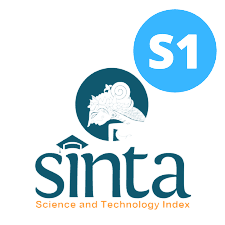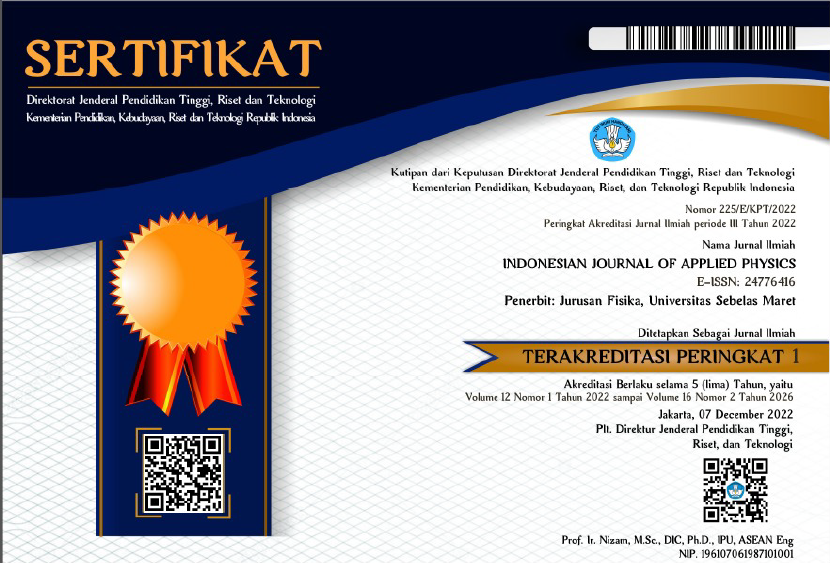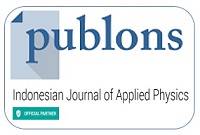A theoretical study of electron impact excitation of the lowest autoionizing states of rubidium using a distorted wave method
Abstract
In this study, we applied distorted wave method to calculate integral cross sections, differential cross sections, and alignment parameters for electron impact excitation of the lowest autoionizing state of Rb. The projectile electron energy we considered is in the range of near threshold up to high energy region (1 keV). We considered static potential of the initial target state as the initial channel distortion potential and a linear combination of static potentials of initial and final target states as the final channel distortion potential. The wave functions used in this model are the multi-zeta and the double-zeta Hartree-Fock single electron wave functions. In order to perform the numerical calculations, we have modified distorted wave Born approximation 1 (DWBA1) program. In the present study, we have evaluated the exchange amplitudes exactly without any approximation. We have compared our results with other theoretical and experimental results available to us. The present results for integral cross sections are in good agreement with experimental results of Borovik. Our distorted wave results are in much better agreement with the experimental result than does the Dirac B-spline R-matrix results of Borovik. Additionally, our alignment parameter results show a near threshold maximum. Furthermore, from the present differential cross sections results it is observed that when the incident energy increases to 200 eV, the cross sections with or without the effect of exchange coincide nearly at all scattering angles.
Keywords
Full Text:
PDFReferences
1 Joachain, C. J. 1975. Quantum collision theory.
2 Ross, K. J. & Ottely, T. W. 1975. Ejected electron spectrum of rubidium autoionizing levels obtained by electron impact excitation, Phys. Lett. A, 54, 57-58.
3 Nygaard, K. J. 1975. Electron impact autoionization in heavy alkali metals. Physical review A, 11(4), 1475.
4 Stapelfeldt, H., Kristensen, P., Ljungblad, U., Andersen, T., & Haugen, H. K. 1994. Autoionizing states of negative ions in strong resonant laser fields: The negative rubidium ion. Physical Review A, 50(2), 1618.
5 Borovik, A. A. 2011. Radiative transitions in the system of autoionizing levels of cesium atoms excited by electron impact. Optics and Spectroscopy, 110, 680-685.
6 Borovik, A., Ilyashevytch, V., Zatsarinny, O., & Bartschat, K. 2012, Nov Resonance excitation of the (4p55s2) 2P3/2, 1/2 autoionizing states in Rb atoms by electron impact. In Journal of Physics: Conference Series (Vol. 388, No. 4, p. 042009). IOP Publishing.
7 Borovik, A., Roman, V., & Kupliauskienė, A. 2012. The 4p6 autoionization cross section of Rb atoms excited by low-energy electron impact. Journal of Physics B: Atomic, Molecular and Optical Physics, 45(4), 045204.
8 Srivastava, R., & Rai, D. K. 1977. Excitation of autoionizing levels in the collision of electrons with alkali-metal atoms. Journal of Physics B: Atomic and Molecular Physics, 10(2), 269.
9 Srivastava, R., Singh, C. S., & Rai, D. K. 1982. Excitation of the lowest autoionising states in alkalis. Journal of Physics B: Atomic and Molecular Physics, 15(12), 1899.
10 Singh, C. S. 2004. Magnetic-sublevel differential cross sections for electron-impact excitation of 21P state of helium. East African Journal of physical sciences, 5, 85-98.
11 Tiwary, S. N., & Rai, D. K. 1975. Electron impact excitation of the lowest autoionizing level in alkali metal atoms. Journal of Physics B: Atomic and Molecular Physics, 8(7), 1109.
12 Kaur, S., & Srivastava, R. 1999. Excitationof the lowest autoionizing np5(n+1) s2, 2P3/2, ½ states of Na (n= 2), K (n= 3), Rb (n= 4) and Cs (n= 5) byelectron impact. Journal of Physics B: Atomic, Molecular and Optical Physics, 32(10), 2323.
13 Pangantiwar, A. W., & Srivastave, R. 1987. e+ or-impact excitation of autoionising levels in alkalis: a distorted-wave approach. Journal of Physics B: Atomic and Molecular Physics, 20(21), 5881.
14 Pangantiwar, A. W., & Srivastava, R. 1988. Excitation of the rubidium atom by electrons and positrons: differential cross section and correlation parameters. Journal of Physics B: Atomic, Molecular and Optical Physics, 21(23), 4007.
15 McDaniel, E. W. 1989. Atomic collisions: electron and photon projectiles.
16 Crothers, D., & McCarroll, R. 1965. Excitation of neutral atoms by electron impact. Proceedings of the Physical Society, 86(4), 753.
17 Roy, B. N., & Rai, D. K. 1973. Electron-impact ionization of Alkali metals. Physical Review A, 8(2), 849.
18 Clementi, E., & Roetti, C. 1974. Roothaan-Hartree-Fock atomic wavefunctions: Basis functions and their coefficients for ground and certain excited states of neutral and ionized atoms, Z≤ 54. Atomic data and nuclear data tables, 14(3-4), 177-478.
19 Madison, D. H., & Bartschat, K. 1996. The distorted-wave method for elastic scattering and atomic excitation. In Computational atomic physics: Electron and positron collisions with atoms and ions (pp. 65-86). Berlin, Heidelberg: Springer Berlin Heidelberg.
20 Clementi, E., Raimondi, D. L., & Reinhardt, W. P. 1967. Atomic screening constants from SCF functions. II. Atoms with 37 to 86 electrons. Journal of Chemical Physics, 47(4), 1300-1307.
21 Furness, J. B., & McCarthy, I. E. 1973. Semiphenomenological optical model for electron scattering on atoms. Journal of Physics B: Atomic and Molecular Physics, 6(11), 2280.
22 Matterstock, B., Huster, R., Paripast, B., & Grum-Grzhimailoz, N. Excitation of K*(3p5 4s22P3p, 2P1/2) by electron impact in the range from near threshold to 500 eV: alignment and cross section ratios. Journal Physic B: Atomic Molecular Optic Physic, 28, 4301-4309.
23 DuBois, R. D., Mortensen, L., & Rodbro, M. 1981. Collisionally induced alignment produced by electron and light-ion impact: Auger electron emission following 2p ionisation and excitation. Journal of Physics B: Atomic and Molecular Physics, 14(10), 1613.
24 Andersen, N. & Bartschat, K. 1993. Comment. At. Mol. Phys. 29, 157-88
25 Bray, I. 1995. Calculation of electron-impact ionization of lithium-like targets. Journal of Physics B: Atomic, Molecular and Optical Physics, 28(7), L247.
26 Jobunga, E., Okumu, J., & Singh, C. S. 2012. Excitation cross-section evaluation for the lowest auto-ionizing state of potassium. The African Review of Physics, 7.
Refbacks
- There are currently no refbacks.
















